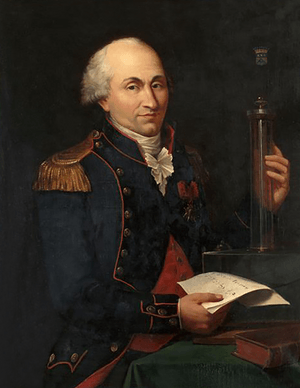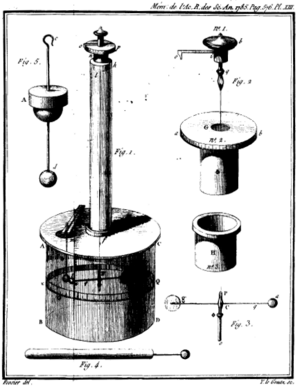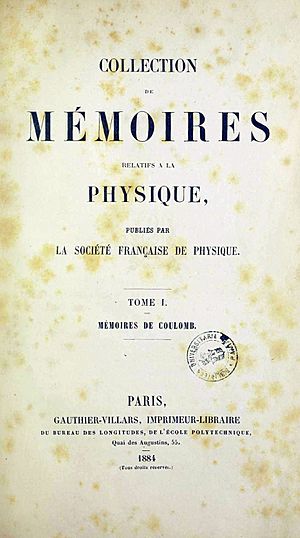Charles-Augustin de Coulomb facts for kids
Quick facts for kids
Charles-Augustin de Coulomb
|
|
|---|---|

Portrait by Hippolyte Lecomte (1894 copy)
|
|
| Born | 14 June 1736 |
| Died | 23 August 1806 (aged 70) |
| Nationality | French |
| Alma mater | École royale du génie de Mézières |
| Known for | Torsion balance Coulomb's law Coulomb friction Coulomb damping Mohr-Coulomb theory |
Charles-Augustin de Coulomb (born June 14, 1736 – died August 23, 1806) was a French officer, engineer, and physicist. He is famous for discovering Coulomb's law. This law describes the electric force that pulls or pushes charged objects. He also did important work on how things rub against each other, which is called friction.
The unit for electric charge in the SI system is named the coulomb in his honor. This happened in 1880.
Contents
Life of Charles-Augustin de Coulomb
Charles-Augustin de Coulomb was born in Angoulême, France. His father was an inspector for the royal lands. His family moved to Paris when he was young. There, he studied at Collège Mazarin. He learned about philosophy, languages, and literature. He also got a good education in math, astronomy, chemistry, and botany.
When his family faced money problems, he had to leave Paris. He went to Montpellier. Later, he returned to Paris. In 1760, he passed the exams for the École royale du génie de Mézières. He graduated in 1761. After graduating, he joined the French army as an engineer. He had the rank of lieutenant.
Coulomb's Engineering Career
For the next twenty years, Coulomb worked as an engineer in many places. He helped build structures, forts, and worked with soil. His first job was in Brest. In 1764, he went to Martinique in the West Indies. There, he was in charge of building a new fort called Fort Bourbon. This job lasted until 1772. The three years in Martinique made him sick. This affected his health for the rest of his life.
When he came back to France, Coulomb was sent to Bouchain. He started writing important papers about how machines work. In 1773, he shared his first work with the Académie des Sciences in Paris. In 1779, Coulomb went to Rochefort. He helped build a fort made of wood near Île-d'Aix. While in Rochefort, he continued his research. He used the shipyards there as his laboratories.
Discovering Coulomb's Law
Also in 1779, he published an important study on the laws of friction. This was called Théorie des machines simples. Later, he discovered how the force between electric charges works. He found that the force gets weaker as the distance between them increases. It follows an inverse square relationship. He found the same relationship for magnetic poles. These relationships were later named Coulomb's law.
In 1781, he was in Paris. When the Revolution started in 1789, he left his job. He retired to his small estate in Blois. He was later called back to Paris. He helped set up the new system of weights and measures. He became one of the first members of the French National Institute. In 1802, he was made an inspector of public instruction. His health was very weak, and he died in Paris four years later.
Coulomb is remembered as a pioneer in geotechnical engineering. This field deals with how soil and rocks behave. He helped design retaining walls. His name is also one of the 72 names written on the Eiffel Tower.
Coulomb's Scientific Research
In 1784, Coulomb published a paper called Recherches théoriques et expérimentales sur la force de torsion et sur l'élasticité des fils de metal. This paper shared the results of his experiments. He studied the twisting force, or torsion, in metal wires. He used a special device called a torsion balance.
Electricity and Magnetism Studies
In 1785, Coulomb shared his first three reports on electricity and magnetism:
- "Premier Mémoire sur l’Électricité et le Magnétisme": In this report, Coulomb explained how to build and use an electric balance. This balance used the twisting property of metal wires. He also found the law that describes how two objects with the same type of electricity push each other away.
- "Second Mémoire sur l’Électricité et le Magnétisme": Here, Coulomb figured out the laws for how magnetic and electric "fluids" act. He showed that the force between two oppositely charged spheres is related to their charges. It is also related to the square of the distance between them. This means if you double the distance, the force becomes four times weaker.
- "Troisième Mémoire sur l’Électricité et le Magnétisme": This report looked at how much electricity an isolated object loses over time. This happens when it touches less humid air or certain supports.
He published four more reports in the following years:
- "Quatrième Mémoire" (1786): This report showed two main things about electric fluid. First, it doesn't spread into objects based on chemical attraction. Instead, it divides itself among different objects that touch. Second, in objects that conduct electricity, the fluid spreads out on the surface. It does not go inside the object.
- "Cinquième Mémoire" (1787): This paper explained how electric fluid divides itself among conducting objects that touch. It also described how this fluid is spread on different parts of an object's surface.
- "Sixième Mémoire" (1788): This continued his research on how electric fluid spreads among several conductors. It also determined the electric density at different points on the surface of these objects.
- "Septième Mémoire" (1789): This report focused on magnetism.
Coulomb explained the laws of attraction and repulsion for electric charges and magnetic poles. However, he did not find a connection between these two phenomena. He thought they were caused by different kinds of "fluids."
Contributions to Friction Research
Coulomb also made big contributions to the study of tribology. This is the science of friction, wear, and lubrication. He completed the most complete study of friction in the 1700s. He is known as one of the important "Men of Tribology."
See also
 In Spanish: Charles-Augustin de Coulomb para niños
In Spanish: Charles-Augustin de Coulomb para niños
- List of things named after Charles Coulomb






